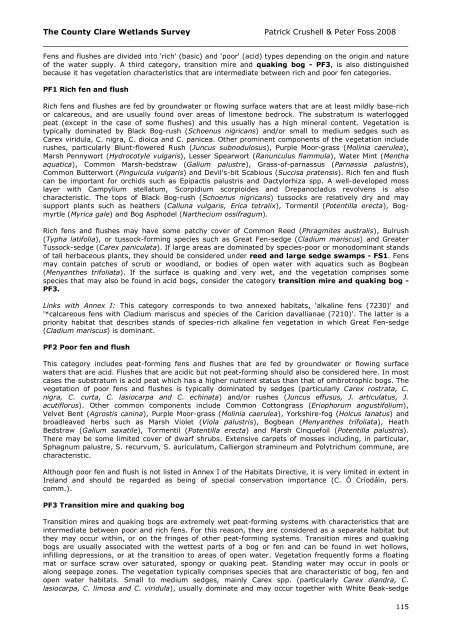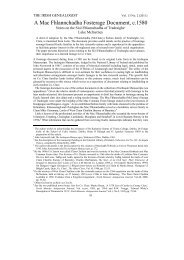Report Cover Vol I - Clare County Library
Report Cover Vol I - Clare County Library
Report Cover Vol I - Clare County Library
You also want an ePaper? Increase the reach of your titles
YUMPU automatically turns print PDFs into web optimized ePapers that Google loves.
The <strong>County</strong> <strong>Clare</strong> Wetlands Survey Patrick Crushell & Peter Foss 2008<br />
_______________________________________________________________<br />
Fens and flushes are divided into 'rich' (basic) and 'poor' (acid) types depending on the origin and nature<br />
of the water supply. A third category, transition mire and quaking bog - PF3, is also distinguished<br />
because it has vegetation characteristics that are intermediate between rich and poor fen categories.<br />
PF1 Rich fen and flush<br />
Rich fens and flushes are fed by groundwater or flowing surface waters that are at least mildly base-rich<br />
or calcareous, and are usually found over areas of limestone bedrock. The substratum is waterlogged<br />
peat (except in the case of some flushes) and this usually has a high mineral content. Vegetation is<br />
typically dominated by Black Bog-rush (Schoenus nigricans) and/or small to medium sedges such as<br />
Carex viridula, C. nigra, C. dioica and C. panicea. Other prominent components of the vegetation include<br />
rushes, particularly Blunt-flowered Rush (Juncus subnodulosus), Purple Moor-grass (Molinia caerulea),<br />
Marsh Pennywort (Hydrocotyle vulgaris), Lesser Spearwort (Ranunculus flammula), Water Mint (Mentha<br />
aquatica), Common Marsh-bedstraw (Galium palustre), Grass-of-parnassus (Parnassia palustris),<br />
Common Butterwort (Pinguicula vulgaris) and Devil's-bit Scabious (Succisa pratensis). Rich fen and flush<br />
can be important for orchids such as Epipactis palustris and Dactylorhiza spp. A well-developed moss<br />
layer with Campylium stellatum, Scorpidium scorpioides and Drepanocladus revolvens is also<br />
characteristic. The tops of Black Bog-rush (Schoenus nigricans) tussocks are relatively dry and may<br />
support plants such as heathers (Calluna vulgaris, Erica tetralix), Tormentil (Potentilla erecta), Bogmyrtle<br />
(Myrica gale) and Bog Asphodel (Narthecium ossifragum).<br />
Rich fens and flushes may have some patchy cover of Common Reed (Phragmites australis), Bulrush<br />
(Typha latifolia), or tussock-forming species such as Great Fen-sedge (Cladium mariscus) and Greater<br />
Tussock-sedge (Carex paniculata). If large areas are dominated by species-poor or monodominant stands<br />
of tall herbaceous plants, they should be considered under reed and large sedge swamps - FS1. Fens<br />
may contain patches of scrub or woodland, or bodies of open water with aquatics such as Bogbean<br />
(Menyanthes trifoliata). If the surface is quaking and very wet, and the vegetation comprises some<br />
species that may also be found in acid bogs, consider the category transition mire and quaking bog -<br />
PF3.<br />
Links with Annex I: This category corresponds to two annexed habitats, 'alkaline fens (7230)' and<br />
'*calcareous fens with Cladium mariscus and species of the Caricion davallianae (7210)'. The latter is a<br />
priority habitat that describes stands of species-rich alkaline fen vegetation in which Great Fen-sedge<br />
(Cladium mariscus) is dominant.<br />
PF2 Poor fen and flush<br />
This category includes peat-forming fens and flushes that are fed by groundwater or flowing surface<br />
waters that are acid. Flushes that are acidic but not peat-forming should also be considered here. In most<br />
cases the substratum is acid peat which has a higher nutrient status than that of ombrotrophic bogs. The<br />
vegetation of poor fens and flushes is typically dominated by sedges (particularly Carex rostrata, C.<br />
nigra, C. curta, C. lasiocarpa and C. echinata) and/or rushes (Juncus effusus, J. articulatus, J.<br />
acutiflorus). Other common components include Common Cottongrass (Eriophorum angustifolium),<br />
Velvet Bent (Agrostis canina), Purple Moor-grass (Molinia caerulea), Yorkshire-fog (Holcus lanatus) and<br />
broadleaved herbs such as Marsh Violet (Viola palustris), Bogbean (Menyanthes trifoliata), Heath<br />
Bedstraw (Galium saxatile), Tormentil (Potentilla erecta) and Marsh Cinquefoil (Potentilla palustris).<br />
There may be some limited cover of dwarf shrubs. Extensive carpets of mosses including, in particular,<br />
Sphagnum palustre, S. recurvum, S. auriculatum, Calliergon stramineum and Polytrichum commune, are<br />
characteristic.<br />
Although poor fen and flush is not listed in Annex I of the Habitats Directive, it is very limited in extent in<br />
Ireland and should be regarded as being of special conservation importance (C. Ó Críodáin, pers.<br />
comm.).<br />
PF3 Transition mire and quaking bog<br />
Transition mires and quaking bogs are extremely wet peat-forming systems with characteristics that are<br />
intermediate between poor and rich fens. For this reason, they are considered as a separate habitat but<br />
they may occur within, or on the fringes of other peat-forming systems. Transition mires and quaking<br />
bogs are usually associated with the wettest parts of a bog or fen and can be found in wet hollows,<br />
infilling depressions, or at the transition to areas of open water. Vegetation frequently forms a floating<br />
mat or surface scraw over saturated, spongy or quaking peat. Standing water may occur in pools or<br />
along seepage zones. The vegetation typically comprises species that are characteristic of bog, fen and<br />
open water habitats. Small to medium sedges, mainly Carex spp. (particularly Carex diandra, C.<br />
lasiocarpa, C. limosa and C. viridula), usually dominate and may occur together with White Beak-sedge<br />
115
















